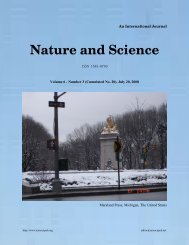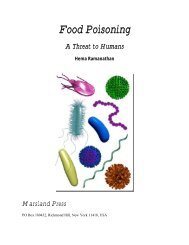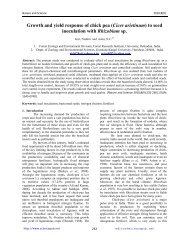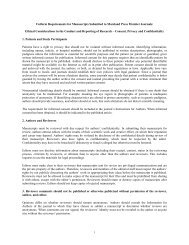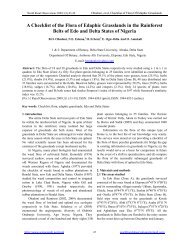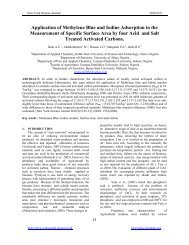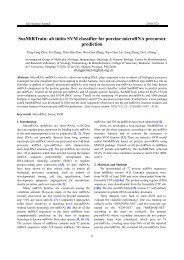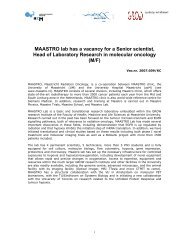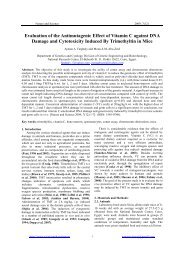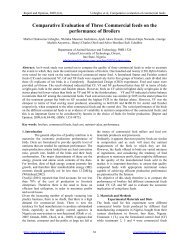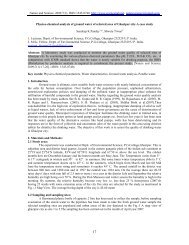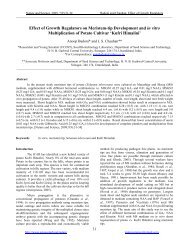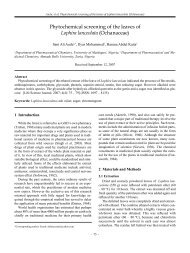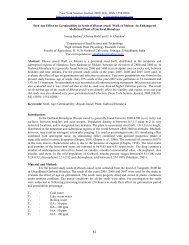Full Text
Full Text
Full Text
You also want an ePaper? Increase the reach of your titles
YUMPU automatically turns print PDFs into web optimized ePapers that Google loves.
Researcher 2010;2(8)<br />
Sorption Isotherm, Particle Size, Chemical And Physical Properties<br />
Of Cocoyam Corm Flours<br />
C.I. Owuamanam 1 , Ihediohanma, N.C 1 and E.C Nwanekezi 2<br />
1 Department of Food Science and Technology Federal University of Technology PMB 1526, Owerri.<br />
2. Department of Food Science and Technology Imo State University, PMB 2000, Owerri<br />
e-mail: icliffowums@yahoo.com<br />
ABSTRACT: The sorption isotherm, particle size chemical and physical properties cocoyam corm flours were<br />
studied in order to enhance the storage and their applications in food formulation. Cocoyam corms: Colocasia<br />
exculenta cv ede cocoindia, Colocasia exculenta cv ede ofe, Xanthosoma sagittifolium cv ede uhie and Xanthosoma<br />
sagittifolium cv ede ocha were processed into flour. The flours were subjected to analysis to determine their<br />
equilibrium moisture content at different relative humidity, particle size distribution, chemical and physical<br />
properties. The equilibrium moisture content at 30 o C determined over varied relative humidity showed differences in<br />
the amounts of moisture absorbed while the sorption isotherm curves obtained revealed typical type II isotherm.<br />
Moreover the monolayer values obtained differed among the cultivars. Chemical properties determined were<br />
moisture content, crude proteins, fibre, fat, and ash as well as the carbohydrate content. Also, the physical properties<br />
investigated were the particle size, water absorption capacity, viscosity, bulk density, porosity, gelatinization<br />
temperature, blue value index, pH and solid density. Mean water absorption capacity: 2.195g/g, 2.410g/g. 2.178g/g<br />
and 2.0082g/g were recorded for ede cocoindia, ede ofe, edeuhie and ede ocha respectively. Also gelling<br />
temperature: 63.8 o C, 96.8 o C, 65 o C and 73.8 o C for ede coconidia, ede ofe, ede uhie and ede ocha respectively. The<br />
results show that the physicochemical properties of cocoyam corm flours are comparable to other root crops and<br />
could be used in various food formulations. [Researcher. 2010;2(8):11-19]. (ISSN: 1553-9865).<br />
Key words: Cocoyam corms; equilibrium moisture; Water activity; Sorption isotherm; Chemical and Physical<br />
properties.<br />
1. INTRODUCTION<br />
Taro (Colocasia esculenta) and Tannia<br />
(Xanthosoma sagittifolium) are the important species<br />
of edible aroids grown in tropical and sub tropical<br />
countries (FAO, 2006). They contribute significantly<br />
to the carbohydrate diet, even though ranked less<br />
important after yam, cassava and potato (Obomeghei.<br />
et al. 1998; FAO, 2006). Cocoyam is produced in<br />
abundance in eastern part of Nigeria, but less valued<br />
in this area as it is regarded as staple food for rural<br />
dwellers, the poor and the less privileged in society<br />
(IITA, 1992). Enwere (1998) reported that the<br />
corms and cormels are cooked and pounded with<br />
cassava or yam into fufu and eaten with stew or soup,<br />
and that the cormels are exclusively used as a<br />
thickener in preparation of soup. The nutritional and<br />
chemical compositions as reported by FAO (2006)<br />
shows that cocoyam if fully exploited would enhance<br />
the food security of people living in the Tropics. A<br />
major problem of cocoyam is that the corms are<br />
susceptible to physical damage during harvesting and<br />
thus leading to high post harvest losses (Onwueme<br />
and Simha, 1991; FAO, 2006). To overcome these<br />
losses, Onyeike et al. (1995) reported that the corms<br />
and cormels may be processed into flour. Kwarteng<br />
and Towler (1994) reported that the flours stores<br />
much longer than the unprocessed tubers of cocoyam.<br />
http://www.sciencepub.net/Researcher<br />
Researcher/135@gmail.com<br />
11<br />
The need to widen the scope of information on the<br />
physical, chemical and engineering characteristics<br />
has been stressed by FAO (2006). This will improve<br />
cocoyam competitiveness along side other roots and<br />
tuber crops, enhance its application in other food<br />
systems and improve marketing potential. Cocoyam<br />
flour can be used in making biscuits or as composites<br />
in bread making (Idowu et al., 1996). The corm’s<br />
flour is a good source of carbohydrate for diabetics<br />
and production of weaning food for infants and for<br />
those with gastrointestinal disorders (Onwueme,<br />
1978). The taro and tannia flours in precooked forms<br />
may find good uses in pie filling, binder in sausage<br />
and as emulsifier in food systems (Fagbemi and<br />
Olaofe, 1998). In the current study, sorption<br />
isotherm, physical and chemical properties of<br />
cocoyam flour are reported. This is expected to<br />
provide information for those involved in processing<br />
of flour and its application in food formulation.<br />
2. Materials and Methods<br />
2.1 Sample preparation:<br />
Wholesome cocoyam cormels (Colocasia<br />
esculenta cv ede ofe, Colocasia esculenta cv ede<br />
cocoindia, Xanthosoma sagitifo litium cv ede ocha<br />
and Xanthosoma sagittifolium cv edeuhuie) used in<br />
this study were harvested on the month of
Researcher 2010;2(8)<br />
November, 2008 from an experimental farm at Imo<br />
State University Owerri, Nigeria. The cornels were<br />
cleaned, peeled and sliced with stainless kitchen<br />
knife and washed with tap water. The slices were<br />
treated with 20ppm solution of sodium<br />
metabisulphate in water for 20min. The slices were<br />
subsequently treated with hot water for 5min and<br />
then oven dried at 70 o C. The dried samples were<br />
milled into flour and stored in air-tight containers.<br />
2.2 Chemical Composition:<br />
Moisture content crude protein, fibre, fat,<br />
ash and carbohydrate were determined according to<br />
AOAC (1990).<br />
2.2.1 Moisture Content Determination<br />
The moisture cans were washed and dried in<br />
the oven and weighed using analytical weighing<br />
balance. Five (5 g) grams of the sample were put into<br />
previously weighed moisture can. The sample in the<br />
moisture can was put into the oven (Gallenkamp Hot<br />
box size 1, air- dried type) at 105 o C for 3.0 h. The<br />
sample was removed and placed in the desiccators to<br />
cool and weighing was carried out afterwards. The<br />
sample was reheated and cooled intermittently until<br />
constant mass was obtained. The difference in mass<br />
as percent moisture was calculated as the % moisture<br />
content.<br />
2.2.2 Crude Protein Determination<br />
The Kjeldahl apparatus was used for the<br />
determination of crude protein. One half (0.5 g)<br />
grams of each dry sample was weighed and put into a<br />
Kjeldahl digestion flask. One tablet of Selenium<br />
catalyst was added into each of the flask moistened<br />
with distilled water and mixed with 10 ml of<br />
concentrated H2SO4. The mixture was heated to redhot<br />
temperature under a fume cupboard for 2 h to<br />
obtain a clear solution. The digest was transferred<br />
quantitatively to 100 ml volume flask and diluted to<br />
mark with distilled water. An aliquot of the digest (10<br />
ml) was mixed with equal volume of 45% NaOH<br />
solution in a semi-micro kjeldahl distillation<br />
apparatus. The mixture was distilled and the distillate<br />
collected into 10 ml of 4% boric solution containing<br />
3 drops of mixed indicator (methyl red and<br />
bromocressol green). A total of 50 ml distillate was<br />
collected and titrated against 0.02N H2SO4 solution.<br />
A blank experiment was also set involving digestion<br />
of all the materials except the sample. The distillation<br />
was also carried out on the blank. The titre value of<br />
the blank was subtracted from that of the sample and<br />
the difference obtained was used to calculate the<br />
crude protein.<br />
http://www.sciencepub.net/Researcher<br />
Researcher/135@gmail.com<br />
12<br />
The percent nitrogen content was calculated a<br />
% crude protein = % N x 16.25.<br />
2.2.3 Crude Fibre Determination<br />
Two (2 g) grams of each sample were<br />
digested with 200 ml of 1.25% H2SO4 solution under<br />
reflux for 30 min boiling. The digest was allowed to<br />
cool and then filtered with Buckner funnel equipped<br />
with muslin cloth. The residue was washed thrice<br />
with hot water, scooped into a conical flask and<br />
digested with 200 ml of 1.25% NaOH solution under<br />
reflux for 30 min boiling. The digest was cooled,<br />
filtered and washed thrice with distilled water. The<br />
residue was drained and scooped into a previously<br />
dried and weighed crucible and then put into the oven<br />
to dry at 105 e C to a constant mass. The dish with its<br />
content was reweighed after drying and then placed<br />
in the muffle furnace to ash at temperature of 550 0 C<br />
for 3 h. The ash was withdrawn at the end and put in<br />
a bell jar and reweighed. The difference in mass of<br />
the sample was calculated as crude fibre and<br />
expressed as a percent of the initial mass.<br />
2.2.4 Ash Determination<br />
Two (2 g) grams of the sample was weighed<br />
into previously cleaned, dried crucible of known<br />
mass. The crucible with the content was weighed and<br />
the mass recorded. The crucible with the content was<br />
placed into a muffle furnace at 550 o C for 3 h until the<br />
sample turned white and free from carbon. At the end<br />
of incineration, the ash substance was withdrawn and<br />
cooled in a bell jar and reweighed. The mass of the<br />
residual incinerate was calculated as % ash content.<br />
% ash = Mass of Ash x 100<br />
Mass of Sample<br />
2.2.5 Carbohydrate Determination<br />
The carbohydrate content was determined<br />
by deference that is by deducting the mean values of<br />
other parameters that were determined from 100.<br />
Therefore %carbohydrate =100-<br />
(%mc+%CP+%fat+crude fibre+%Ash).<br />
Where mc= moisture content; cP = crude protein.<br />
2.3 Physical Properties<br />
2.3.1 Particle Size:<br />
The method of Idowu et al. (1996) was used.<br />
Test sieves of various apertures (90µm, 75µm and 50<br />
µm) were arranged in ascending order and mounted<br />
on the test sieve shaker. 30g of the flour was put in<br />
the top sieve and covered with the lid. The shaker<br />
was switched on and operated for 30min after which<br />
the sieves were removed and the retained amount was<br />
determined by weighing. The percent retention of
Researcher 2010;2(8)<br />
each sieve was calculated. Means values were<br />
calculated after four determinations.<br />
2.3.2 Viscosity:<br />
The brook field synchrolectric viscometer<br />
was used to determine the viscosity of slurry made<br />
from the flour. Twenty (20) g of the flour was put in<br />
250ml beaker and 200ml of tap water added to form<br />
slurry. The slurry was heated at 100 o C for 15 min to<br />
gelatinize. The brook field synchrolectric viscometer<br />
was set at zero and 60 rev per minute. The viscosity<br />
of the pap was determined when the spindle revolves<br />
60 time/minute.<br />
2.3.3 Blue Value Index (BVI):<br />
The method of Atkins (1982) was followed.<br />
Three (3) g of the flour was weighed into 50ml<br />
beaker and 30ml dispersion made and allowed to<br />
stand for 30min 30C, which was filtered afterward<br />
with whatman (No 42) filter paper. 10ml of the<br />
filtrate was measured into 25ml conical flask and<br />
titrated with O.I.N iodine solution using<br />
phenophtalein as indicator. The titre value was<br />
recorded at the blue colour end point. Percent blue<br />
value index was calculated as:<br />
%BVI = VD x Vt x N x 100<br />
VA Mf 100 I<br />
Where : VD = Total volume of dispersion;<br />
VA=Volume of aliquot used for filtration; Vt<br />
=Titre value;<br />
Mf =Mass of flour used;<br />
N=Normality of iodine.<br />
2.3.4 Water Absorption Capacity:<br />
The method of Abbey and Ibeh (1988) was<br />
followed to determine water absorption capacity. One<br />
(1) gram of the flour was mixed with tap water in a<br />
centrifuge tube and made up to 10ml dispersion and<br />
allowed to rest at room temperature for 30mins. The<br />
sample was centrifuge at 3000rpm with Heltich<br />
model centrifuge. The volume of the supernatant was<br />
measured using 10ml graduated cylinder. The density<br />
value 1000kg/m3 was assumed and mean water<br />
absorption capacity obtained after four<br />
determinations in (g/g).<br />
2.3.5 Gelatinization Temperature:<br />
The method of Narayana and Narasinta –<br />
Rao (1982) was adopted with slight modification.<br />
Twenty five (25) grams of the flour was dissolved in<br />
tap water in a beaker and made up to 100ml<br />
dispersion. The dispersion was placed on heating<br />
mantle and stirred as heating progresses. The gelling<br />
temperature was recorded at the gelling point of the<br />
flour in 0 C.<br />
http://www.sciencepub.net/Researcher<br />
Researcher/135@gmail.com<br />
13<br />
2.3.6 Bulk Density:<br />
The method of Milson and Kirk (1980) was<br />
followed to determine the bulk density. Fifty (50)<br />
grams of the sample was weighed into 100ml<br />
graduated cylinder and the initial volume recorded.<br />
The cylinder was tapped repeatedly for 100 times to a<br />
constant volume and the final volume recorded. The<br />
bulk density was calculated as the mass of the sample<br />
divided by the volume at the end of tapping.<br />
2.3.7 Porosity: The porosity was calculated using the<br />
values obtained for the case of bulk density: thus<br />
Porosity = Initial volume – Final volume<br />
Initial volume<br />
3.4 Data Analysis<br />
The data obtained from the study were<br />
subjected to analysis of variance (ANOVA)<br />
procedure of Steel and Torrie (1980) and the Fisher’s<br />
least significant difference (LSD) used to separate<br />
significantly differing means as described by<br />
Roessler (1984).<br />
3. Results and Discussion<br />
3.1 Sorption Isotherm:<br />
The sorption isotherm curves are presented<br />
in Figure 1. The cocoyam corm flours exhibited<br />
sigmoid shape which is typical of type II isotherm<br />
going by Brunauer et al. (1938) classification and is<br />
also in agreement with the works of Aguerre et al.<br />
(1996). The various flours adsorbed minimal amount<br />
of water at a region of water activity (aw) 0.0 - 0.25,<br />
which the moisture is unavailable for reactions<br />
(monolayer adsorption). At aw, 0.65 the equilibrium<br />
moisture content was within the amount suitable to<br />
maintain shelf stability for dehydrated food as stated<br />
by Lewis (1990). The colocasia cultivar, ede<br />
cocoindia adsorbed the highest amount 0.13 at 65%<br />
humidity while ede ofe had the least 0.10 (Table 2).<br />
At aw range from 0.00 - 0.7, the uptake of moisture<br />
was gradual but raised sharply at aw range 0.70- 0.97.<br />
The sudden rise in moisture uptake in the range 0.70 -<br />
0.97 corroborates previous works by Nanjundaswany<br />
et al. (1976); Mir and Nath (1995) and Ariahu et al.<br />
(1999). The high sugar content of these flours might<br />
be responsible for the high moisture uptake at aw<br />
range 0.70 and above. Pezzutti and Crapiste (1997)<br />
attributed the moisture uptake to physical adsorption<br />
of water on polymeric molecules. Moreover the rate<br />
of moisture uptake or sorption kinetics might be<br />
associated with the large surface areas of the flours.<br />
Sorption isotherm gives the relationship between<br />
water activity and water content of the food material<br />
at particular temperature and at certain humidity.<br />
According to Nwanekezi (2007) sorption isotherm<br />
enables processors to evaluate a drying process.
Researcher 2010;2(8)<br />
The monolayer moisture content ranged<br />
from 0.0353- 0.0471 gH20/g solid with ede uhie<br />
having the highest value, 0.0471gH2O/g solid as<br />
presented in Table 1. Onwuka (2003) listed<br />
monolayer range, 0.0320- 0.160g H2O/g solid for<br />
some dry starchy flours. Monolayer moisture content<br />
is a measure of sorption possibility of starchy food<br />
(Kiranoudis et al., 1993). It is the minimum amount<br />
of water bound to active sites and guaranties the<br />
stability of flour during storage (Iglesias et al., 1975).<br />
The higher the monolayer values the more the<br />
stability of the flour. Thus suggesting that ede uhie<br />
provides more binding sites for water molecules and<br />
would be least stable in storage, while ede ocha with<br />
the lowest monolayer value might store for longer<br />
time than the rest.<br />
3.2 Chemicial Properties:<br />
The result of proximate composition is<br />
shown in Table 2. The percent crude protein differed<br />
significantly (P< 0.05) with ede ofe scoring the<br />
highest, 11.36% while cocoindia had the least value<br />
of 7.88%. Also the crude fibre differed significantly<br />
(P< 0.05). Okpokiri (1981) obtained 9.2% protein for<br />
ede ocha while FAO (2006) reported crude protein<br />
(wet weight basis), 1.8% for Colocasia esculanta and<br />
2.0% for Xanthosoma sagittifolium corms. Protein<br />
content plays important role in water absorption<br />
capacity of flour in food systems. The carbohydrate<br />
contents of all the cultivars were high when<br />
compared to other parameters, thus signifying that<br />
cocoyam is a rich source of energy for human<br />
nutrition. However among the cultivar ede uheie<br />
contributed the highest amount of carbohydrate than<br />
the rest (Table 2). Onwueme (1978) reported that<br />
cocoyam corm is a source of carbohydrate for<br />
diabetics and for those with gastrointestinal disorders.<br />
These may suggest that cocoyam corms contain<br />
slowly digestible starches and dietary fibre which are<br />
of nutritional importance (Srilakshmi, 2008).<br />
3.3 Particle Size:<br />
The results of particle size distribution of the<br />
samples were as shown in Table 3. Major portions of<br />
the flours were retained in the 90μm mesh and the<br />
percent retention differed significantly (P
Researcher 2010;2(8)<br />
spoilage by all sorts of microorganisms. Therefore<br />
the extension of storage life may necessitate the use<br />
of chemical anti microbial agents and anti oxidants.<br />
3.7 Solid Density (SD):<br />
The xanthosoma spp had high score of SD<br />
than the colocasia counterpart. Among xanthossoma,<br />
ede uhie had the highest SD value of 0.344g/cm 3<br />
while ede ofe of colocasia had the least SD value of<br />
0.297g/cm 3. SD is important in food separation<br />
process such as sedimentation, centrifugation, and in<br />
pneumatic and hydraulic transportation of powders<br />
particulate foods Lewis (1987). SD is desirable<br />
quality factor for assessment of flours.<br />
3.7Bulk Density and Porosity:<br />
The bulk density of the cultivars as<br />
presented in Table 6 indicates that the xanthosoma<br />
spp scored high than the colocasia spp. ede ocha and<br />
ede uhie did not differ significantly(p
Researcher 2010;2(8)<br />
Equilibrium Moisture Content<br />
0.5<br />
0.45<br />
0.4<br />
0.35<br />
0.3<br />
0.25<br />
0.2<br />
0.15<br />
0.1<br />
0.05<br />
0<br />
0.11 0.33 0.56 0.65 0.75 0.8 0.9 0.97<br />
Water Activity<br />
Figure 1: Sorption Isotherm of flours from cocoyam corms at 30 o C<br />
Table 1. Monolayer moisture content of Cocoyam Corms’ Flour<br />
Cultiver Monolayer (Mo)gH2O/g solid<br />
Ede uhie 0.0471<br />
Ede ocha<br />
Cocoindia<br />
Ede ofe<br />
0.0353<br />
0.0438<br />
0.0409<br />
ede ofe<br />
Cocoindia<br />
Ede Uhie<br />
Ede Ocha<br />
Table 2. Chemical Properties Cocoyam Corm Flour<br />
Colocasia esculenta Xanthosoma Sagittifolium<br />
Chemical<br />
properties (%)<br />
Cocoindia Ede ofe Ede Uhie Ede ocha LSD<br />
Ash 3.50 a ± 1.6x 10 -2 3.15 b ± 5.2x10 -3 3.00 a ± 0.00 2.45± 6x10-4 2.7x10-4<br />
Fat 0.82 a ± 6x10 -3 0.78 a ± 0.0 0.8 a ± 9.6x10-3 0.74 a ± 1.89x10-2 Nil<br />
Crude Protain 7.88 d ± 1.4x10 -2 11.36 a ± 1.3x10 -2 8.08 c ± 1.2x10-2 8.74 b ± 2.0 0.0179<br />
Moisture content 8.55 a ±1.6x10 -2 10.68 a ± 8.1x10 -2 8.73 a ± 1.2x10-2 8.60 a ± 2.4x10-2 Nil<br />
Fibre 0.46 c ±8.2x10 -4 0.48 b ±8.1x10 -3 0.20 d ±8.2x10 -3 0.99 a ± 8.2x10 -3 0.0319<br />
Carbohydrate 78.79 b ±4.2x10 -2 73.55 d ±3.7x10 -2 78.82 a ±0.1 78.5 c ±7.5x10 -2 0.0949<br />
.Mean + standard deviation of quadruplet determination on dry weight basis. Means with similar alphabets across<br />
the row are not significant different at P
Researcher 2010;2(8)<br />
Table 3. Particle Size Distribution of Cocoyam Corm Flours<br />
Mesh Size Cocoindia ede ofe ede uhie ede ocha LSD<br />
90µm (%) 96.29 b ± 0.06 97.42 a ± 0.25 95.57 c ± 0.03 95.44 c ± 0.09<br />
0.375<br />
75µm (%) 1.44 b ± 0.01 0.50 c ± 0.02 1.45 b ± 0.03 2.30 a ± 0.02<br />
0.034<br />
50µm (%) 2.27 c ± 0.4 2.11 d ± 0.09 4.08 a ± 0.02 2.88 b ± 0.03<br />
0.102<br />
Mean quadruplet samples of Cocoyam corn flours. Means of samples with similar alphabets across the row are not<br />
significant at P
Researcher 2010;2(8)<br />
5. REFERENCES<br />
1. Abbey, B.N. and C.O. Ibeh (1988): Functional<br />
properties of raw and heat processed cowpea<br />
flour. J. Food Scl. 53: 1775-1777.<br />
2. Adeyemi and Omolayo (1984): Utilization of<br />
cocoyam flour and starch for biscuits and cake<br />
making. J. Food Scl. 18 (12): 34 – 37.<br />
3. Aguerre, R.J., P.E. Voillaz and C. Suares (1996):<br />
A fractal Isotherm for multilayer adsorption in<br />
foods, J. .Food Engineering 30: 227-238.<br />
4. Akobundu, E.N.T., J.P Cherry and J.G. Simons<br />
(1982): Chemical Functional and Nutritional<br />
Properties of Egusi (Colocynthis Citrusilus L.<br />
Seed protein product. J. Food Scl. 47: 829-835.<br />
5. A.O.A.C (1990) Official Methods of Analysis<br />
(13 th Ed), Association of Official Analytical<br />
Chemists, Washington, D.C U.S.A p 222-225.<br />
6. Atkins, P.W. (1982): Physical Chemistry (2nd)<br />
English Language Book Society and Oxford<br />
University chemists Washington DC USA Pp.<br />
222-225.<br />
7. Ariahu, C.C., U.Ukpabi, and K.O. Mbajunwa<br />
(1997): Production of African breadfruit<br />
(Triculia africana) and soyabean (Glycine max)<br />
seed based food formulations 2. Effects of<br />
germination on mirobiological and physical<br />
properties, J. Plant Foods for Human Nutrition,<br />
54: 207-216.<br />
8. Ayenor, S.G. (1985): The yam (Discorea)<br />
starches in: Advances in yam research. United<br />
Industries and Shipping Inc. Enugu. Pp. 79 – 87.<br />
9. Brunauer, S., P.H. Emmett, E. Teller (1938):<br />
Adsorption of gases on multilayers, J. Am Chem.<br />
Soc. 60: 309-319.<br />
10. Caurie, M. (1981): A monolayer equation for use<br />
in sorption studies. Journal of Food , 47: 332.<br />
11. Enwere, N.J. (1998): Foods of plant origin, Afro-<br />
Orbis Pubs. Ltd. Nsukka, Nigeria p 151-152.<br />
12. Fagbemi, T.N and O. Olaofe (1998): Functional<br />
Properties of Raw and Pre-cooked Raro<br />
(Colocasia esculenta) and Tannia (Xanthosoma<br />
sagittifolium) Flours, In Proc. 22 nd Ann. NIFST<br />
Confer. Abeokuta ,154-155.<br />
13. FAO (2006):<br />
http//www.fao.org/inpho/content/text/ch25_01.ht<br />
m Accessed 12/22/2006.<br />
14. Greenspan, L. (1977): Humidity fixed pointsof<br />
binary saturated aqueous solutionsJ.Res Wat.<br />
Bur. Stand, 81a: 89-112.<br />
15. Greer, F.N. and B.A. Stewart (1959): Processing<br />
cassava and its products. FOA Rome, Italy. Pp.<br />
84-85.<br />
16. Holleman, L.W.J and A. Aten (1956) Processing<br />
of cassava and its Products FAO, Rome, Italy p<br />
84- 85<br />
http://www.sciencepub.net/Researcher<br />
Researcher/135@gmail.com<br />
18<br />
17. Idowu, M.A. A. Onia and B.M. Amusa (1996):<br />
bread and Biscuit making potentials of some<br />
Nigeria Cocoyam Cultivars. Nig. Food J. 14:<br />
141-142.<br />
18. Iglesias, H.A., J. Chirife, and J.L. (1975):<br />
Comparison of Water Vapor sorption by sugar<br />
beet components, J.Food Technol 10:385.<br />
19. IITA (1992): Substantial food production in sub-<br />
Saharan Africa. IITA Ibadan P. 85<br />
20. Iwuoha, C.I. and F.A. Kalu (1995): Calcium<br />
oxalate and physiochemical properties of<br />
cocoyam: Colococasia esculenta and xanthosoma<br />
sagitifocium tuber flours as affected by<br />
processing. J. Food Chemistry. 54:61-66.<br />
21. Kiranoudis, C.T., Z.B. Maroulis, E. Tsami and<br />
D. Marnos-Kouris (1993): Equilibrium moisture<br />
content and heat of adsorption of some<br />
Vegetables, J. Food Engineering 20: 55-74.<br />
22. Kwarteng, J.A. and Towler, M.J. (1994): West<br />
African Agriculture. A <strong>Text</strong>book for Schools and<br />
Colleges. Macmillan Pub. London Pp 128- 129.<br />
23. Lewis , M.J (!987): Density and specific gravity<br />
of Foods. In: Physical properties of foods and<br />
food processing systems. Ellis Howard Ltd ,<br />
Chichester, England p 53-57.<br />
24. Milson, A. and O. Kirk (1980): principles of<br />
design and operation of catering equipments.<br />
Ellis Howard, Chichester West Success. Pp. 27-<br />
30.<br />
25. Mir, M.A. and N. Nath (1995): Sorption<br />
Isotherm of Fortified Mango bars, J. Food<br />
Engineering, 25: 141-150.<br />
26. Narayana and Narasanya – Rao (1982):<br />
International Workshop on small Scale<br />
Processing of Tropical Root Crops. Hinoluhu<br />
1:136-140.<br />
27. Nanjunswamy, A.M., Shetty, G.R. and Saroja, S.<br />
(1976): Studies on the development of newer<br />
products from mango. J. Indian Food Packer,<br />
30(5): 95-102.<br />
28. Nwanekezi E.C (2007): Fundamentals of food<br />
processing engineering, supreme pub. Owerri,<br />
Nigeria. p 258- 261.<br />
29. Obomeghei, A.A., Obafemi, M.O. and Oyibo, S.<br />
(1998): Processing parameters for cocoyam flour<br />
production In: Pro. 22 nd Annual Conf. of<br />
Nigerian Inst. of Food Sci, and Tech. 12- 16 Oct.<br />
Abeokuta, Nigeria, p 131- 152.<br />
30. Okpokiri, A.O. (1981): Screening of cocoyam<br />
varieties for flour production. In: Annual<br />
NRCRI. Umudike p 22.<br />
31. Onwueme, I.C. (1978): The Tropical Tuber<br />
Crops, yam, cassava, sweet potato and cocoyam.<br />
John Wiley and Sons. New york and Brisbane<br />
Toronto. P 199-227.
Researcher 2010;2(8)<br />
32. Onwueme, I.C. and T.D. Simha (1991): Field<br />
Crop Production in Tropical Africa. CTA Ed,<br />
Netherlands p 276-288.<br />
33. Onwuka N.D.K., (2003). Essential elements of<br />
food and related processes engineering, UCO-<br />
Academic pub Nsukka, Nigeria. pp 116-118.<br />
34. Onyeike, E.N. Olungwe, T. and Uwakwe, A.A.<br />
(1995): Effects of heat treatment and defatting on<br />
the proximate composition of some Nigerian<br />
local soup thickeners. J. Food Chemistry 53:<br />
173- 175.<br />
35. Pezzutti, A. and Crapsite (1997) Sorptional<br />
equilibrium and drying characteristics of garlic,<br />
J. Food Engineering 31: 113-123.<br />
7/7/2010<br />
http://www.sciencepub.net/Researcher<br />
Researcher/135@gmail.com<br />
19<br />
36. Sakai; W.S. (1979): Aroid Root Crop In:<br />
Tropical Foods, Chemistry and Nutrition. New<br />
York 1: 268-269.<br />
37. Steel, R.G.D. and Torrie, J.H. (1980). Analysis<br />
of variance 111: factorial experiments. In:<br />
Principles and Procedures of Statistics – A<br />
Biometrical Approach. 2 nd edn. McGraw-Hill<br />
Int’l Coy. London pp 336- 376.<br />
38. Srilakshmi, B. (2008) Nutritional Science (third<br />
edition), New Age International (P) Limited<br />
Publishers new Delhi, P 21- 39.<br />
39. Zurith, C.R., P. Somgh, S.M. Moini and S.M.<br />
Henderson (1979): Desorption Isotherm of<br />
Rough Rice from 10-40oC, Trans ASAE , 22:<br />
433-469.



